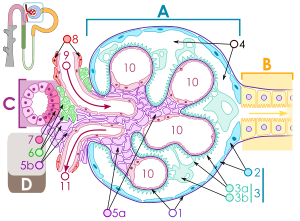
Extraglomerular mesangial cell
Encyclopedia

Kidney
The kidneys, organs with several functions, serve essential regulatory roles in most animals, including vertebrates and some invertebrates. They are essential in the urinary system and also serve homeostatic functions such as the regulation of electrolytes, maintenance of acid–base balance, and...
found outside the glomerulus
Glomerulus
A glomerulus is a capillary tuft that is involved in the first step of filtering blood to form urine.A glomerulus is surrounded by Bowman's capsule, the beginning component of nephrons in the vertebrate kidney. A glomerulus receives its blood supply from an afferent arteriole of the renal...
, near the vascular pole
Vascular pole
The vascular pole is a location of the glomerulus. At the vascular pole, the afferent arterioles and efferent arterioles enter the Bowman's capsule.The urinary pole is at the other end....
and macula densa
Macula densa
In the kidney, the macula densa is an area of closely packed specialized cells lining the wall of the distal tubule at the point of return of the nephron to the vascular pole of its parent glomerulus, ....
.
Lacis cells form the juxtaglomerular apparatus
Juxtaglomerular apparatus
The juxtaglomerular apparatus is a microscopic structure in the kidney, which regulates the function of each nephron. The juxtaglomerular apparatus is named for its proximity to the glomerulus: it is found between the vascular pole of the renal corpuscle and the returning distal convoluted tubule...
in combination with two other types of cells: the macula densa
Macula densa
In the kidney, the macula densa is an area of closely packed specialized cells lining the wall of the distal tubule at the point of return of the nephron to the vascular pole of its parent glomerulus, ....
of the distal convoluted tubule
Distal convoluted tubule
The distal convoluted tubule is a portion of kidney nephron between the loop of Henle and the collecting duct system.- Physiology :It is partly responsible for the regulation of potassium, sodium, calcium, and pH...
and juxtaglomerular cells of the afferent arteriole. This apparatus controls blood pressure
Blood pressure
Blood pressure is the pressure exerted by circulating blood upon the walls of blood vessels, and is one of the principal vital signs. When used without further specification, "blood pressure" usually refers to the arterial pressure of the systemic circulation. During each heartbeat, BP varies...
through the Renin-Angiotensin-Aldosterone system. The specific function of Lacis cells is not well understood, although it has been associated with the secretion of erythropoietin
Erythropoietin
Erythropoietin, or its alternatives erythropoetin or erthropoyetin or EPO, is a glycoprotein hormone that controls erythropoiesis, or red blood cell production...
.

